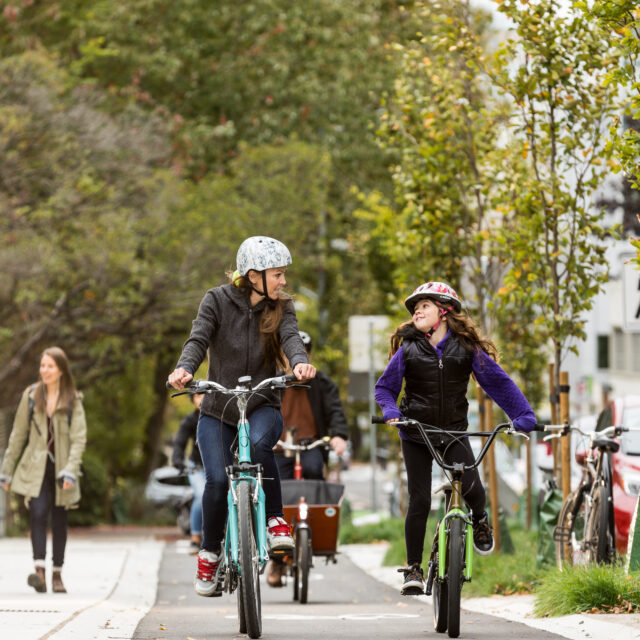Does bike share complement or replace public transit?
by Kiran Herbert, Communications Manager
February 16, 2022
A recent study suggests that bike share does indeed play a role in solving the first-/last-mile problem.

A rider on a VeoRide dockless bike near the University of Illinois at Urbana-Champaign. (Photo courtesy of the Bike Share With Veo project)
Few systems have fully merged shared micromobility with transit but that doesn’t mean that they shouldn’t: When done correctly, it can make mobility more accessible and affordable for everyone. A recent study — from researchers Rebecca Martin and Yilan Xu at the University of Illinois at Urbana-Champaign — examined whether or not a dockless bike share system, complete with GPS-tracked electric bikes and a mobile app, had a casual impact on public transit.
Since 2014, bus ridership in the United States has been on a decline. At the same time, bike share systems have grown in popularity, with many cities going dockless and/or expanding to include electric bikes. There has been a fair amount of speculation about whether or not the latter has contributed to the former yet scant scientific work has been done to examine the relationship. This new study seeks to bridge the research gap.
In theory, traditional bike share might replace, work in unison with, or have no effects on bus transit, and the more widespread adoption of technological innovations in bike share only complicate the combined effects. An e-bike, for example, might make a three-mile journey considerably faster than a public bus. On the flip side, residents can use bike share to replace a portion of a longer transit trip, or to reach a transit stop in the first place, serving as a first-/last-mile solution. And of course, if a bike share trip replaces a walking or car trip, or instigates a journey that otherwise wouldn’t have happened, it would have no effect on transit.
In order to determine bike share’s effect on public transportation, researchers decided to study their local system, VeoRide, in the Champaign-Urbana region of Illinois, a metropolitan area with some 240,000 people. VeoRide began in the fall of 2018 with a fleet of 500 pedal bikes and then phased in e-bikes after seven months of service, ultimately replacing 80% of its fleet. Because the bikes were phased in, researchers were able to study the system as it evolved, evaluating the effect of both dockless pedal bikes and e-bikes on transit all within the same geographic footprint.
According to Xu, the biggest challenge to pinpointing the effect of bike share on bus ridership is that ridership naturally varies from year to year due to factors the researchers couldn’t measure. Thus, simply comparing bus ridership before and after VeoRide was introduced wouldn’t measure the true effect. Instead, Xu and Martin compared the differences in ridership between dry and rainy hours across years, knowing that all types of bicycling decline when it rains. Because Champaign-Urbana is a university town, the researchers also differentiated between on-campus and off-campus use.
Xu and Martin found that pedal bikes with a dockless system increased bus ridership by 1% and that electric bikes with a dockless system increased bus ridership by 2.1%. In Champaign-Urbana, that means that the tech-enhanced bike share could increase public transit ridership between 120,000 and 252,000 passenger trips in a year. Additionally, they found that increased bus ridership occurred where and when the demand for travel arose — off-campus in the morning and on-campus in the evening — suggesting that tech-enhanced bike share helps solve the first-/ last-mile problem. What’s more, the locations of use suggest that socioeconomically disadvantaged and young people benefited more from the option of bike share.
“This is encouraging news to bike share and traditional public transit systems,” says Xu.
Based on the data, Xu and Martin offer suggestions for future areas of study — namely, examining user decision-making regarding different modes — as well as recommendations for city planners and city governments.
“Governments may want to invest in infrastructure like bike lanes and facilitate a bike-friendly community and encourage bike share companies to distribute their bikes in spots that would solve the first/last mile problem,” says Xu. “Finally, transit systems and bike share systems may want to create partnerships to integrate charging systems that allow transfers between bike share and bus ride. This is going to create a win-win for both parties and benefit consumers.”
We couldn’t agree more. We’re excited to have this research to amplify the conversation around integration, as well as support the efforts of our Living Lab in Detroit, where MoGo bike share is working to merge bike share and transit.
The Better Bike Share Partnership is funded by The JPB Foundation as a collaboration between the City of Philadelphia, the National Association of City Transportation Officials (NACTO) and the PeopleForBikes Foundation to build equitable and replicable bike share systems. Follow us on Facebook, Twitter and Instagram or sign up for our weekly newsletter. Got a question or a story idea? Email kiran@peopleforbikes.org.



